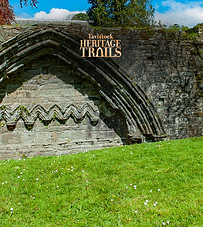ABOUT TAVISTOCK
Tavistock lies on the western edge of Dartmoor National Park, about 15 miles north of Plymouth. Its name is derived from the River Tavy, which flows through the town, and ‘stoc’ which is an Old English word for settlement.
For over 900 years Tavistock was dominated by two wealthy and powerful institutions: the medieval Benedictine abbey and the Dukes of Bedford.
Under the patronage of the abbey, Tavistock grew to become a market town, a significant producer of woollen cloth, a parliamentary borough and one of Devon’s three original stannary towns.


Tavistock Abbey was founded between 972 and 975 by Ordulph, the brother in-law of King Edgar who unified separate Anglo Saxon kingdoms to create England. Tavistock was one of 22 new monasteries created in Edgar’s reign to control the countryside. The location was strategically important because it was close to the border with Cornwall. In 997 the abbey was sacked by Danish raiders and subsequently rebuilt. The site of the Saxon and Norman buildings, which were probably timber, is not known.
The abbey was part of the Benedictine Order which stressed the need for obedience, communal prayer, daily reading and manual labour. Wealthy patrons gave money and land in the hope of salvation when they died. The buildings which survive date from the 12th to 16th centuries and reflect how Tavistock became the wealthiest monastery in Devon and Cornwall.
Ancient manuscripts show that the monks of Tavistock’s Benedictine Abbey were the people who created the Cream Tea. When the Abbey was badly damaged in the Viking raid of 997, restoration was undertaken by Ordulf, Earl of Devon, who rewarded his workers with bread, clotted cream and strawberry preserves made by the monks. A Devon cream tea! The cream teas became so popular that the monks continued to serve them to passing travellers.
Tavistock received its Market Charter from Henry I in 1105 and the town prospered from its weekly markets, being the centre of a large farming district. A market has taken place here without a break for 900 years. The town's Market used to be held in Bank Square, now a car park, but in 1860 the Seventh Duke of Bedford moved the River Tavy sideways and built a magnificent Market Hall surrounded by delightful small shops.
At the Dissolution of the Monasteries in 1539, Henry VIII transferred the abbey and most of its assets to John Russell, the first in a succession of Earls and Dukes of Bedford to own most of the town. In the 19th century Tavistock’s economy and society were transformed by the expansion of metal mining, mainly for copper, around the town and in the Tamar Valley.
By 1817 the Tavistock Canal had been dug (most of the labour being performed by French prisoners of war from the Napoleonic Wars) to carry copper to Morwellham Quay on the River Tamar, where it could be loaded into sailing ships weighing up to 200 tonnes. The 6th and 7th Dukes used the revenues from copper mines on their land to redevelop the town centre, provide fine public buildings including the Guildhall and Pannier Market, and erect ‘model’ cottages for industrial workers.
In 2006 the global significance of West Devon’s mining industries and the Dukes’ architectural legacy were recognised when Tavistock and the Tamar Valley were included in the UNESCO Cornwall and West Devon Mining Landscape World Heritage Site, placing us on a par with international treasures like Machu Picchu, the Taj Mahal and the Great Wall of China. It forms the largest industrial World Heritage Site in the UK, with over 20,000 hectares spread over across Cornwall and West Devon.
Tavistock’s most famous son, Sir Francis Drake, was born around 1540 at Crowndale Farm on the outskirts of Tavistock to the west of Tavistock College. A Blue Plaque is mounted on the current farmhouse. The original farmhouse was dismantled and the stone transported for use in Lewtrenchard. He became a sailor and navigator, and the first Englishman to circumnavigate the globe. He is probably most famous for defeating the Spanish Armada off the coast of Plymouth and, popular legend has it that on receiving word of the sightings of the Spanish fleet, Sir Francis Drake remarked that there was plenty of time to finish the game and defeat the Spanish. A bronze statue of Sir Francis Drake stands at the south western end of the A386 Plymouth Road. Cast in 1883 by Sir Joseph Edgar Boehm (1834-90), there is a replica on Plymouth Hoe. Drake later made his home at Buckland Abbey, about eight miles away towards Plymouth.
From July 1943 until May 1944, American soldiers of the 29th Infantry Division of the US Army were based at Abbotsfield Hall in Tavistock, commanded by Major General Charles. H. Gerhard. Part of V Corps United States 1st Army, the task that lay ahead for them was the invasion of Europe - now known as the D-Day landings - and they used their base in Tavistock to prepare for the military maneouvre.
Tavistock today is a thriving market town - the largest in West Devon - with a population of around 14,000. It's enviable location on the doorstep of the Dartmoor National Park and a stone's throw from the Tamar Valley National Landscape makes Tavistock the perfect holiday base, a hub for adventure and a shopper’s paradise




